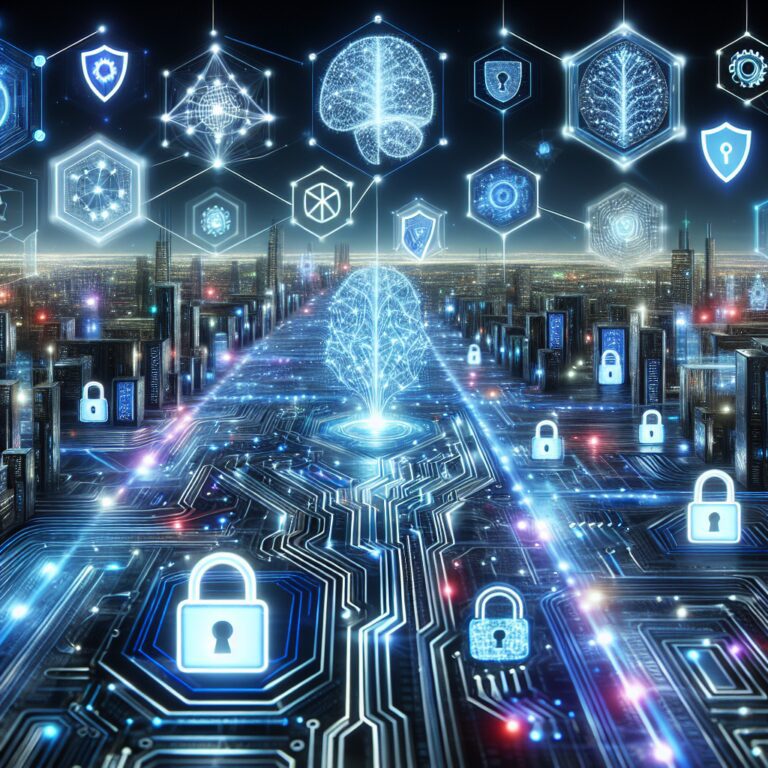
“`html
Emerging Cybersecurity Risks and AI Strategies for 2025
Introduction
Cybersecurity is morphing at a breakneck pace! As we hurdle toward 2025, emerging risks are not just looming; they’re shaping the very fabric of our digital infrastructures. Today, we’re exploring a compelling subject: the convergence of Artificial Intelligence and cybersecurity. AI isn’t merely a buzzword suitable for boardroom presentations; it’s a key player in both escalating and mitigating cybersecurity threats. This isn’t a fleeting trend—it’s a seismic shift demanding our immediate attention. Whether you’re a seasoned cybersecurity professional or just riding the wave of transformation, understanding these risks and strategies could be your lifeline in navigating the volatile seas ahead.
Let’s dive in, shall we?
The Rising Tide of Cybersecurity Threats
The cybersecurity landscape for 2025 is fraught with challenges that require us to rethink traditional methods. The increasing sophistication of cyberattacks is a red flag we cannot ignore. Consider the proliferation of AI-powered hacking tools—ah, the irony—designed to infiltrate networks with uncanny precision.
Emerging Threats
- AI-Powered Malware: Cybercriminals are now employing AI to develop malware with adaptive capabilities, learning from detection mechanisms to always stay one step ahead.
- Deepfakes and Misinformation: AI’s devious gift to cyber threats; creating hyper-realistic deepfakes that are increasingly credible, posing risks to both reputations and information integrity.
- IoT Vulnerabilities: With billions of IoT devices, we are basically painting a target on our backs. As IoT networks expand, so do the opportunities for exploitation.
- Supply Chain Attacks: Destructive and stealthy; where hackers infiltrate through third-party vendors to sabotage businesses from within.
Decoding AI-Driven Threat Detection
AI isn’t just a weapon for attackers; it’s also the fortress we need to build stronger defenses. AI-driven threat detection is revolutionary, not an evolutionary step. It entails utilizing vast datasets and machine learning algorithms to predict, analyze, and autonomously counteract threats.
What’s Changing?
- Real-Time Analysis: AI systems can crunch data faster than any human, identifying potential threats in the blink of an eye.
- Anomaly Detection: Machine learning algorithms pin down unusual patterns, isolating them from vast pools of normal network behavior.
- Behavioral Biometrics: Using AI, we can detect changes in typing speed, mouse movement, and other traits to catch unauthorized access attempts.
Using AI for threat detection has been a game-changer, but it’s not a silver bullet yet. The adaptability of machine learning means that threat actors are continually testing the limits of these systems, compelling cybersecurity professionals to stay vigilant and innovative.
Data Protection Strategies and Networking Protocols
With great data comes great responsibility. Data protection is an integral piece of the cybersecurity puzzle that demands attention, especially when quantum computing capabilities are on the horizon, threatening current encryption standards.
Advanced Data Protection Measures
- Quantum-Resistant Encryption: Preempt future threats by investing in quantum-resistant algorithms to protect sensitive data.
- Zero-Trust Architecture: Adopt a “never trust, always verify” model to scrutinize every attempt to access network resources.
- Data Masking: Replace sensitive information with generalized equivalents to maintain user privacy during data processing.
Future Network Security Protocols
Let’s not overlook how network security protocols are morphing! The need for resilient frameworks is ever-growing amid the rising complexity of cyber threats.
- Secure Access Service Edge (SASE): Combines networking and security functions into one unified platform, providing consistent security services.
- Multi-Factor Authentication (MFA): Bolster your network with additional layers of verification to keep unauthorized users at bay.
- Software-Defined Networking (SDN): Decouples the control and data planes, increasing flexibility in evolving network landscapes.
Real-World Applications, Challenges, and Future Implications
What does this all mean in the real world? For starters, implementing these technologies means overcoming operational challenges like integration complexity, budget constraints, and the shortage of skilled professionals.
Challenges
- Integration Issues: Plugging new AI systems into legacy frameworks without creating new vulnerabilities is a substantial hurdle.
- Cost Constraints: Cutting-edge solutions come with hefty price tags, which might not fit every organization’s budget.
- Skills Gap: The skills necessary to manage burgeoning AI technologies are still scarce, posing challenges for rapid implementation and adaptation.
Implications for the Future
– Cybersecurity will become increasingly intertwined with AI, changing the roles and responsibilities within organizations.
– Regulatory frameworks will evolve to keep pace with technological advancements, necessitating continual adaptation by businesses.
– The continual escalation in threat complexity will perpetuate a cycle of innovation in cybersecurity solutions.
Conclusion
As we chart our course toward 2025, embracing the evolving face of AI-driven cybersecurity isn’t optional—it’s essential. Whether through improving detection accuracy, developing robust data protection strategies, or deploying cutting-edge network security protocols, our actions in the coming years will define the digital frontier. Now is the time for cybersecurity professionals to harness the dual-edged power of AI, maximizing its defensive potential while staying vigilant against its offensive capabilities.
Adapt, innovate, and prepare—because the future is here, and it’s time we shape it!
References
– Smith, Jane. “Emerging Cybersecurity Risks and AI Strategies for 2025.” Mondaq. October 2023. [Link](https://www.mondaq.com/unitedstates/new-technology/1554076/ai-cybersecurity-and-digital-infrastructureemerging-risks-and-strategies-for-2025)
– Palo Alto Networks. “The Evolving Role of Artificial Intelligence in Cybersecurity.” October 2023.
“`




